|
|
 |
|
July 2000- My travels in Venezuela typically take me to the south (such as Roraima and Canaima) or the west (to Choroni or Merida). Despite all of my travelling here I never have ventured to the Oriente (the East). A three-day weekend at the end of July finally afforded me the time to explore this part of Venezuela. Jo and I took an early morning flight to Maturin, where we rented a Ford Explorer for the weekend. We were fortunate because our flight was on time and none of our luggage was lost, however despite reservations, the time it took to rent the Explorer ended up testing my patience. Plus it was horribly overpriced and it was 2WD. All of the drawbacks of an SUV (poor handling, bad fuel mileage) and none of the benefits (increased off-road prowess). Despite the problems we were on the road by 10:00 AM and heading to the coast. We drove through the lush green mountains and several small towns along the way. Jo was shocked to find that I was driving at a sane pace, unlike my usual full-throttle assaults on the road. The combination of the beautiful surrounds and unfamiliar vehicle kept me under control. Our trip was just starting so I had no reason to rush through the four-hour drive. I still managed to frustrate Jo though by stopping several times in order to take the "perfect picture" of the landscape. He retaliated by pointing out all of the beautiful flowers we saw along the way, obviously mocking my behavior from our previous trip to Guatopo. |
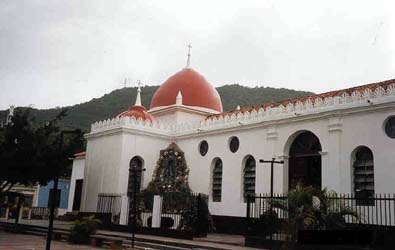 |
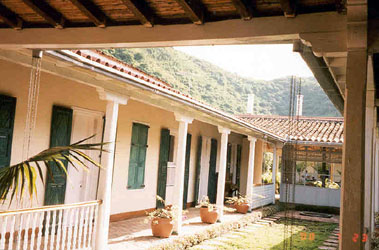 |
|
We arrived in Rio Caribe in the afternoon and we directly to Caribana, a posada recommended to me by a coworker. Despite not having reservations we were fortunate enough to get a room. The posada was very inviting and comfortable, with colonial architecture and large, brightly painted doors. Unfortunately the weather was not as inviting, and following lunch at a local restaurant we were greeted by a steady downpour. The lunch was unimpressive, however on the way to the restaurant we visited the beautiful 18th Century Catholic Church on the town's Plaza Bolivar. After lunch the two of us went back to the posada and played a few hands of cards and a couple games of checkers before boredom drove us out into the foul weather. Jo and I decided to just explore the area and see what we could do the following day. There was a beautiful young Spaniard and her mother staying at the same posada as us, so when we saw the two ladies walking down the street through the rain we asked if they wanted to join us on our trip. We were promptly denied, so the two of us continued on alone into the unknown. We passed through several small, poor villages filled with election propaganda and countless speed bumps. Most of the houses we constructed of mud or bricks and had tin roofs. This construction drove people outside to escape the heat, even on a rainy day. We dodged chickens, pigs, and the occasional donkey while the locals stared at us driving by. After an hour of driving we arrived at Playa Puy Puy, supposedly one of the nicest beaches in the area. I must admit that I was a little disappointed, although the foul weather could have had something to do with my opinion. I also had left my camera at the posada, which did not put me into a better mood. Playa Puy Puy was lined with small cabañas in front of the red sand beach and emerald sea. Although it was nice, I did not find it as visually appealing as the white sand beaches and brilliant blue water found in Los Roques or Morrocoy. After Jo caked his shoes with mud while looking around we headed back to Rio Caribe. The two of us just hung out at the posada the rest of the evening. It was very relaxing, but the service at the restaurant in the Caribana was atrocious. The waiter came up to us (dressed in a t-shirt, shorts, and sandals) after we sat down and just stood in front of us. He didn't greet us or ask what we wanted to drink or say a word. Luckily the food was decent and reasonably priced, but we did not eat at the posada restaurant again. |
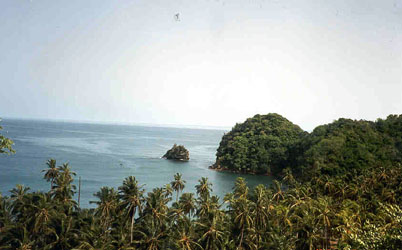 |
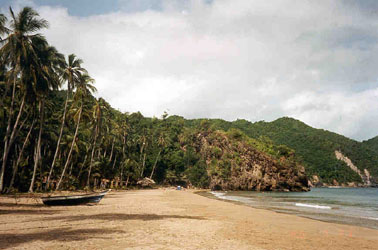 |
|
Sunday morning we slept in until 8:00 AM before going to Playa Medina. Playa Medina is the most famous beach in the Oriente, however after seeing Playa Puy Puy must expectations were lowered. The route to Playa Medina follows the same road as to Playa Puy Puy except for the last 5 kilometers, so the things we saw were much the same as the day before. Along the way Jo and I had a discussion about Venezuelan buying habits. It must be common for people to stop and buy things on the side of the road because everywhere you go there are people trying to sell you things. We saw everything from handcrafted baskets to a guy holding an iguana up by the tail. We made it to Playa Medina without spending too much money, and arrived to find more palm trees than people. It was a warm, sunny day by this time and we could not ask for more. After setting up the hammock and eating our traditional beach breakfast of empanadas (stuffed cornmeal pockets) we just relaxed and watched the people roll in. Unfortunately they just kept coming, and what was a quiet beach at 10:00 AM was covered with people by noon. Luckily Jo and I had secured an open hut and some chairs to lounge in, but the space between the hammock and us was quickly filled with people. Where there was room we played paddleball and swam in the ocean. The rest of the time we just relaxed in the sun and were entertained by a toddler named Fernando, who terrorized other kids with his plastic rake and tossed his mother's things in the sand in order get his juice out of the ice chest. Once Fernando left and we had taken in our fill of the Venezuelan girls the two of us left the beach in the early afternoon. |
 |
|
From the beach Jo and I drove to Hato Rio de Agua, where they raise water buffalo. We drove into the hato and received a warm greeting and a cool drink. We explained that we were interested in spending the afternoon exploring the hato. The two of us each had the opportunity to hold a tame boa constrictor before taking a tour of the grounds. The hato was nice; all of the power for the small facilities comes from solar panels. At this point we were thinking that this was going to be interesting; Jo and I were expecting to take a short tour in the buggy parked in front of the bar. Instead we were offered the chance to paddle a canoe through the channels. That sounded interesting, so the two of us set off by ourselves in the canoe. Actually, "set off" isn't exactly true, since we only managed to pilot the canoe in a zigzag pattern. After half an hour of going nowhere under the blazing sun we decided to head back to land. Unfortunately the workers at the hato had nothing else to offer us so we returned to Rio Caribe. On the drive back to the posada Jo and I started noting more characteristics of our surroundings. When they were not sitting in front of their houses, many of the locals could be found riding bicycles. Not fancy mountain bikes or road bikes mind you, but old BMX bikes patched together from whatever parts they had lying around. Also, no one ever smiled. They just stared at us with blank faces and cold eyes. Once back to the comfort of the Caribana we showered and changed clothes before going out to dinner. We were headed to a pizza place recommended in the Lonely Planet book but at Jo's request we stopped at the Pariana Café. It ended up being a wonderful choice, the food was delicious and the atmosphere was very pleasant. I must say that the cafe had a Bohemian feel to it and was a bit out of place in Rio Caribe, with English, Spanish, and French conversations going on around the room. |
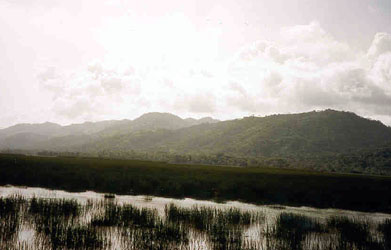 |
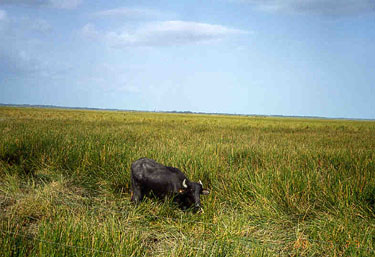 |
|
Monday morning we decided to visit a local cocoa plantation, following the advice of the owner of the café from the night before. We drove up and down the road where the plantation was supposed to be for about an hour without locating it. After stopping for advice and searching a little while longer, Jo suggested that we leave for the Cueva Guácharo. It was already after 10 AM and the cave was over three hours away, plus we had a flight that same evening. Unfortunately Jo got more than he bargained for because I drove like my normal self (in other words, a maniac) in order to get to the cave and not miss our flight. The road between Carupano and Caripe was narrow and poorly maintained, which did not make the task any easier. We arrived at the Cueva Guácharo at 1:15 PM. Cueva Guácharo is the largest cave in Venezuela and was declared a national park in 1949. Guácharo is the Spanish name for the bird which lives in the cave. The birds are unique in that they are nocturnal, they eat only fruit, and they use sonar to travel through the dark. Despite all of the similarities, the guácharos are not bats they are birds. The cave is ten kilometers long, but the tours only explore the first 1 ½ kilometers. After paying the $10 tour fee (as opposed to $3 for Venezuelans) we set off with our guide and a small group of people. As the guide lead us through the dark, damp cave with a propane lantern he pointed out various stalactites and stalagmites. The group struggled to hear the guide over the constant cries of the birds and also struggled to keep our footing on the slippery, rocky floor. Jo and I hoped that the drops we felt landing on our heads and shoulders were water and not caused by the birds perched above. |
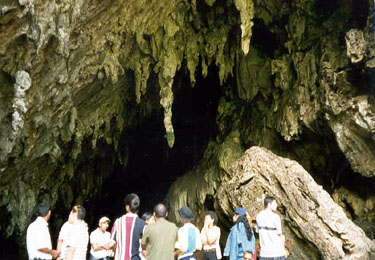 |
 |
|
It took nearly 45 minutes to traverse through the first chamber before we entered the Chamber of Silence. This section is aptly named since it is free of the birds. It was in this section that we were allowed to take pictures too. We continued on for another 45 minutes past more rock formations dotted with minerals before reaching our destination of the Cuarto de los Pechos (Room of Breasts). By this time we were getting short on time before our flight so we quickly exited the cave. After I snapped a few more pictures Jo and I set off for Maturin at a furious pace. I almost got us killed a few times but managed to deliver us to the airport unharmed and with plenty of time to return the Explorer and check in for our flight. If I had to do the trip again I would have gone to Caripe and Cueva Guácharo first and then continue to the beach from there. The road between Caripe and the coast is very beautiful but it is narrow and better enjoyed at slower speeds than the road between Maturin and the Caribbean. |
 |
|
|